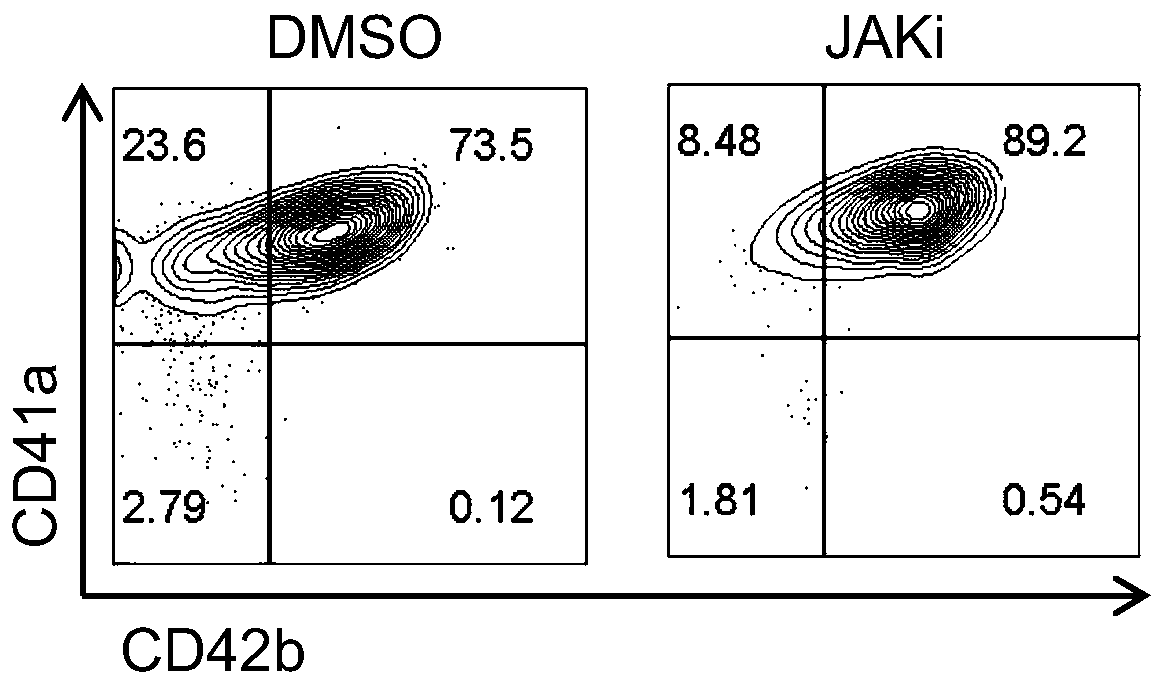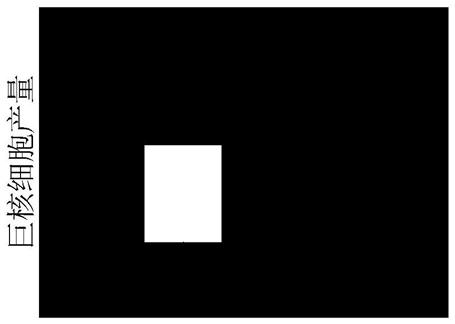Application of JAK (Janus kinase) in preparation of products for promoting induction of multipotent stem cells to generate megakaryocytes and platelets
A pluripotent stem cell and kinase inhibitor technology, applied in artificially induced pluripotent cells, embryonic cells, animal cells, etc., can solve the problems of poor operability, low yield, long cycle, etc., and achieve short differentiation cycle and yield. High and simple operation effect
- Summary
- Abstract
- Description
- Claims
- Application Information
AI Technical Summary
Problems solved by technology
Method used
Image
Examples
Embodiment 1
[0067] Example 1: Preparation of megakaryocytes and platelets
[0068] 1) Preparation of human pluripotent stem cells
[0069] a. According to the human pluripotent stem cell single-cell subculture procedure, digest human pluripotent stem cells with Accutase for 3-5 minutes. After the clones are loose, add DMEM / F12 and pipette with a 1mL gun tip to form single cells.
[0070] b. Centrifuge at 300 g for 5 min at room temperature, and discard the supernatant.
[0071] c. Resuspend the cells in mTeSR medium added with Y-27632 (final concentration: 5 μM), and add 3.5×10 5 Growth Factor Reduced Matrigel (Growth Factor Reduced Matrigel)-coated Petri dishes were seeded at cell densities per 10 cm dish.
[0072] d. After cross-shaking, place at 37°C, 5% CO 2 Incubate for 24 hours in the incubator.
[0073] 2) Hematopoietic differentiation of human pluripotent stem cells
[0074] a. After 24 hours, add Activin A (Activin A, final concentration of 50 ng / mL), bone morphogenetic prot...
Embodiment 2
[0087] Example 2: Detection of producing megakaryocytes
[0088] The DMSO control group and the JAK kinase inhibitor group were respectively set up.
[0089] a. Collect about 1×10 cells on the third day of megakaryotic differentiation 5 The cell suspension was centrifuged at 300 g for 5 min, and the cell pellet was resuspended with 100 μL of 0.2% BSA.
[0090] b. Add 1 μL anti-CD41a-APC (BD) and 1 μL anti-CD42b-PE (BD) flow antibody to each group, incubate in the dark for 30 minutes, and detect CD41a by flow cytometry (FACS Canto II; BD Biosciences) + CD42b + The proportion of megakaryocytes.
[0091] c. The result is as follows figure 2 As shown, on the 3rd day of megakaryotic induced differentiation, the control group (DMSO group) CD41a + CD42b + The proportion of megakaryocytes is over 70%. After treatment with JAK kinase inhibitors, the purity of megakaryocytes can be as high as 90%.
Embodiment 3
[0092] Example 3: Detection of produced platelet particles
[0093] The DMSO control group and the JAK kinase inhibitor group were respectively set up.
[0094] a. Collect the cell suspension on the sixth day of megakaryotic induction, centrifuge at 300 g for 5 min, and take 200 μL of supernatant.
[0095] b. Add 1 μL anti-CD41a-APC (BD) and 1 μL anti-CD42b-PE (BD) flow-type antibodies to each group, incubate in the dark for 30 minutes, and run the machine (FACS Canto II; BD Biosciences) for detection.
PUM
 Login to View More
Login to View More Abstract
Description
Claims
Application Information
 Login to View More
Login to View More - R&D
- Intellectual Property
- Life Sciences
- Materials
- Tech Scout
- Unparalleled Data Quality
- Higher Quality Content
- 60% Fewer Hallucinations
Browse by: Latest US Patents, China's latest patents, Technical Efficacy Thesaurus, Application Domain, Technology Topic, Popular Technical Reports.
© 2025 PatSnap. All rights reserved.Legal|Privacy policy|Modern Slavery Act Transparency Statement|Sitemap|About US| Contact US: help@patsnap.com



